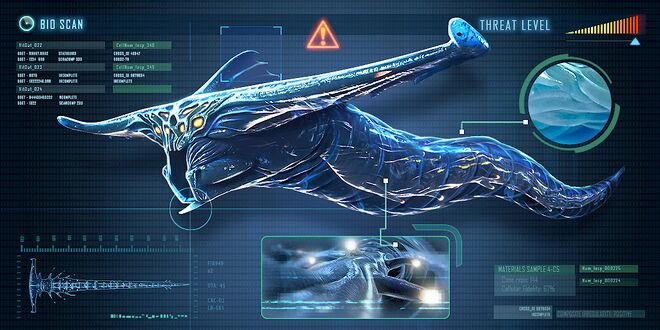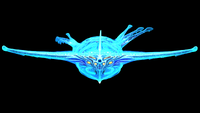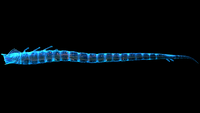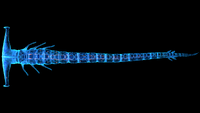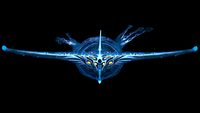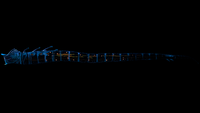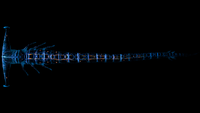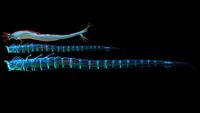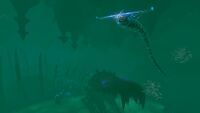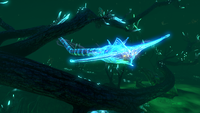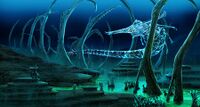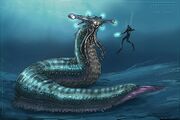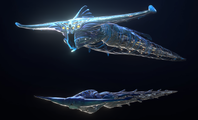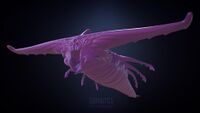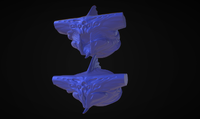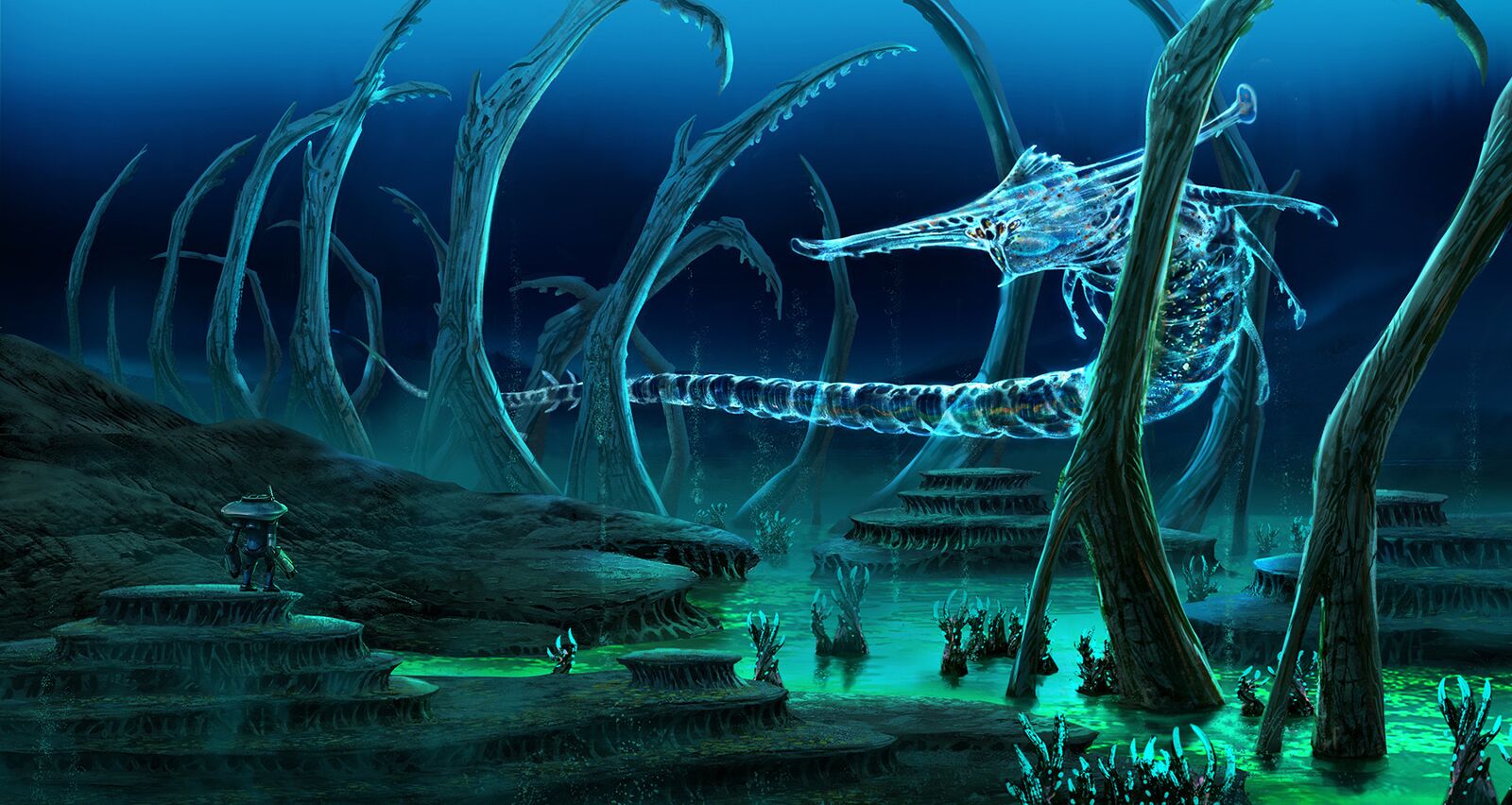Ghost Leviathan Juvenile: Difference between revisions
No edit summary |
MasterTeska (talk | contribs) m (+ interwiki (de)) Tag: 2017 source edit |
||
| (4 intermediate revisions by 4 users not shown) | |||
| Line 11: | Line 11: | ||
*Bite: 220 (Cyclops) |
*Bite: 220 (Cyclops) |
||
|biome = |
|biome = |
||
*[[Lost River |
*[[Lost River]] |
||
* |
**[[Lost River#Bone Fields|Bone Fields]] |
||
* [[Lost River# |
** [[Lost River#Ghost Forest|Ghost Forest]] |
||
** [[Lost River#Mountains Corridor|Mountains Corridor]] |
|||
|active_during = [[:Category:Cathemeral|Cathemeral (Day and Night)]] |
|active_during = [[:Category:Cathemeral|Cathemeral (Day and Night)]] |
||
|length = 67 meters |
|length = 67 meters |
||
|debugspawn = ''ghostleviathanjuvenile'' |
|debugspawn = ''ghostleviathanjuvenile'' |
||
}}Ghost Leviathan Juveniles are the |
}}Ghost Leviathan Juveniles are the immature forms of [[Ghost Leviathan]]s. They measure at around 63% the size of a mature individual living within [[The Crater]], but despite this, they retain the same amount of health as their adult counterparts. However, juveniles deal 34.5% less damage. |
||
Three Ghost Leviathan Juveniles spawn on the map, all within the [[Lost River]] [[Biomes (Subnautica)|biome]]. |
Three Ghost Leviathan Juveniles spawn on the map, all within the [[Lost River]] [[Biomes (Subnautica)|biome]]. |
||
| Line 24: | Line 25: | ||
The [[Giant Cove Tree|Tree Cove]] is currently the only known nesting ground of this leviathan species (although they are not present around the tree), with its massive glowing bulbs being their eggs which are blue and purple. According to PDA scan entries of the Cove Tree, the eggs were laid there when the tree was small, and the branches have grown around the eggs to protect them until conditions are right to hatch. |
The [[Giant Cove Tree|Tree Cove]] is currently the only known nesting ground of this leviathan species (although they are not present around the tree), with its massive glowing bulbs being their eggs which are blue and purple. According to PDA scan entries of the Cove Tree, the eggs were laid there when the tree was small, and the branches have grown around the eggs to protect them until conditions are right to hatch. |
||
The Ghost Leviathans' life cycle begins in the Lost River as juveniles, they consume the [[Ghostray|Ghostrays]] and [[River Prowler|River Prowlers]] and potentially other juveniles. As the leviathans mature and become too large for their home, they migrate to the open, surface world biomes such as the [[Grand Reef]] and [[Blood Kelp Zone]], consuming [[Ampeel|Ampeels]] and [[Crabsquid|Crabsquids]] in the Northern Blood Kelp, and shoals of fish and possibly even [[Sea Treader Leviathan|Sea Treader Leviathans]] in the Grand Reef, until eventually migrating to the [[Crater Edge]], roaming freely in the open water and constantly growing larger until they die.<ref name="GR">http://imgur.com/pqiy0N6</ref><ref>http://imgur.com/8QBPgcc ''Dated July 6, 2017.''</ref> Despite being much smaller than the [[Sea Emperor Leviathan]], the Ghost Leviathan's eggs can be far larger, capable of growing to sizes far too large for the creature to lay, suggesting that the eggs can grow drastically after being laid |
The Ghost Leviathans' life cycle begins in the Lost River as juveniles, they consume the [[Ghostray|Ghostrays]] and [[River Prowler|River Prowlers]] and potentially other juveniles. As the leviathans mature and become too large for their home, they migrate to the open, surface world biomes such as the [[Grand Reef]] and [[Blood Kelp Zone]], consuming [[Ampeel|Ampeels]] and [[Crabsquid|Crabsquids]] in the Northern Blood Kelp, and shoals of fish and possibly even [[Sea Treader Leviathan|Sea Treader Leviathans]] in the Grand Reef, until eventually migrating to the [[Crater Edge]], roaming freely in the open water and constantly growing larger until they die.<ref name="GR">http://imgur.com/pqiy0N6</ref><ref>http://imgur.com/8QBPgcc ''Dated July 6, 2017.''</ref> Despite being much smaller than the [[Sea Emperor Leviathan]], the Ghost Leviathan's eggs can be far larger, capable of growing to sizes far too large for the creature to lay, suggesting that the eggs can grow drastically after being laid. |
||
==Appearance== |
==Appearance== |
||
| Line 104: | Line 105: | ||
<references /> |
<references /> |
||
{{Navbox Fauna}} |
{{Navbox Fauna}} |
||
[[de:Phantom]] |
|||
[[fr:Léviathan Fantôme]] |
[[fr:Léviathan Fantôme]] |
||
[[Category:Aggressive]] |
[[Category:Aggressive]] |
||
| Line 115: | Line 117: | ||
[[Category:Creatures with variants]] |
[[Category:Creatures with variants]] |
||
<center><div style="position: fixed; display: block; margin-left: auto; margin-right: auto; width: 100%; top: -20px; left: 0px; z-index: -1">[[File:LostRiver BonesField V02b lorez.jpg|center| |
<center><div style="position: fixed; display: block; margin-left: auto; margin-right: auto; width: 100%; top: -20px; left: 0px; z-index: -1">[[File:LostRiver BonesField V02b lorez.jpg|center|1600x1600px]]</div> |
||
Latest revision as of 11:25, 27 February 2025
<infobox>
<title source="title1" style="font-weight:bold; text-align:center;"> <default>Ghost Leviathan Juvenile</default> </title> <image source="image1">
</image> <label>Category</label> <label>Tab</label> <label>Description</label> <label>Affiliation</label> <format></format> <label>Age</label> <label>Description when cooked</label> <label>Description when cured</label> <label>Inhabit</label> <label>Attitude</label> <label>Health</label> <label>Damage</label> <label>Adult Damage</label> <label>Juvenile Damage</label> <label>Drops</label> <label>Perks</label> <label>Biome</label> <label>Active During</label> <label>Size</label> <label>Length</label> <label>Bioreactor</label> <label>DNA</label> <label>Voice Actor</label>
<label>Debug Spawn</label> <format>- {{#explode:ghostleviathanjuvenile||0}}
- {{#explode:ghostleviathanjuvenile||1}}
- {{#explode:ghostleviathanjuvenile||2}}
- {{#explode:ghostleviathanjuvenile||3}}
- {{#explode:{{{item_id}}}||0}}
- {{#explode:{{{item_id}}}||1}}
- {{#explode:{{{item_id}}}||2}}
- {{#explode:{{{item_id}}}||3}}
<group layout="horizontal"> <header>Food & Water</header> <label>Food</label> <label>H2O</label> <label>O2</label> </group> <group collapse="open" class="tab-eggs"> <header>Egg</header> <image source="image2"> </image> <label>Tab</label> <label>Description</label> <label>Biome</label> <label>Incubation</label> <label>Bioreactor</label>
<label>Debug Spawn</label> <format>- {{#explode:{{{debugspawn2}}}||0}}
- {{#explode:{{{debugspawn2}}}||1}}
- {{#explode:{{{debugspawn2}}}||2}}
- {{#explode:{{{debugspawn2}}}||3}}
</group> </infobox> Ghost Leviathan Juveniles are the immature forms of Ghost Leviathans. They measure at around 63% the size of a mature individual living within The Crater, but despite this, they retain the same amount of health as their adult counterparts. However, juveniles deal 34.5% less damage. Three Ghost Leviathan Juveniles spawn on the map, all within the Lost River biome.
Life Cycle
The Tree Cove is currently the only known nesting ground of this leviathan species (although they are not present around the tree), with its massive glowing bulbs being their eggs which are blue and purple. According to PDA scan entries of the Cove Tree, the eggs were laid there when the tree was small, and the branches have grown around the eggs to protect them until conditions are right to hatch.
The Ghost Leviathans' life cycle begins in the Lost River as juveniles, they consume the Ghostrays and River Prowlers and potentially other juveniles. As the leviathans mature and become too large for their home, they migrate to the open, surface world biomes such as the Grand Reef and Blood Kelp Zone, consuming Ampeels and Crabsquids in the Northern Blood Kelp, and shoals of fish and possibly even Sea Treader Leviathans in the Grand Reef, until eventually migrating to the Crater Edge, roaming freely in the open water and constantly growing larger until they die.[1][2] Despite being much smaller than the Sea Emperor Leviathan, the Ghost Leviathan's eggs can be far larger, capable of growing to sizes far too large for the creature to lay, suggesting that the eggs can grow drastically after being laid.
Appearance
The Ghost Leviathan has a soft, bioluminescent, transparent outer membrane covering a muscular, blue, inner body which features many darker blue stripes, 12 yellow, bioluminescent eyes as well as six, possibly vestigial fins on the torso section. A small sail sits on top of the head, and two long structures protruding from either side of its head which bear similarities to the cephalofoil of a hammerhead shark. It has a rectangular mouth with a glowing barbule lure beneath. Its long body tapers to a point.
The outer body is transparent, making the smaller, inner body visible. The inner body is long and thin, and covered in pulsating, bioluminescent orange stripes with many orange tipped protrusions ending with blinking bioluminescent orange glows. Unlike the outer body, the inner body has a distinct, thin neck joining the head and body. As the leviathan moves through the water, it leaves trails behind it.
Behavior
To attack a target, it will spiral up and charge. When charging, it will open up its mouth and make a loud, echoing screech. If it successfully attacks, it will do 55 damage to the player then swim some distance away, as if losing interest.
Audio
<soundcloud url="https://soundcloud.com/kamakazi/ghost-leviathan-20" height="166" width="100%" class="soundCloud" />
Data Bank Entry
|
This large predator has adapted to live in deep waters and dark cave systems, attacking anything and everything in its quest to grow larger.
1. Torso: Soft outer membrane and elongated body enable superior navigation of tight cave environments. Displays some similarities to other eel-like predators in the area, however the ghost leviathan has covered over the electrical prongs on its inner torso with a taut, transparent membrane which delivers superior maneuverability.
2. Diet: In its juvenile state this leviathan feeds on larger herbivores, and unfortunate members of its own species. They display a remarkable rate of growth which shows no signs of stopping, suggesting that they must abandon their hatching grounds before they grow too large and make for more open waters.
Assessment: Avoid |
Gallery
<tabber> Screenshots=
Size comparison between an adult and a juvenile Ghost Leviathan, as well as a Reaper Leviathan
The juvenile found in the Ghost Forest
|-| Videos=
- SN GhostLeviathan 03
Ghost Leviathan FX
|-| Concept Art=
|-| Models=
Models from Sketchfab
Highpoly model from Sketchfab
Highpoly head model from Sketchfab
Lowpoly model from Sketchfab
</tabber>
References
- ↑ http://imgur.com/pqiy0N6
- ↑ http://imgur.com/8QBPgcc Dated July 6, 2017.
Lua error in package.lua at line 80: module 'Dev:Navbox' not found.

